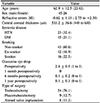1. Hyman L, Wu SY, Connell AM, et al. Prevalence and causes of visual impairment in The Barbados Eye Study. Ophthalmology. 2001; 108:1751–1756.
5. Grunwald JE, Piltz J, Hariprasad SM, DuPont J. Optic nerve and choroidal circulation in glaucoma. Invest Ophthalmol Vis Sci. 1998; 39:2329–2336.

6. Schulzer M. Intraocular pressure reduction in normal-tension glaucoma patients. The Normal Tension Glaucoma Study Group. Ophthalmology. 1992; 99:1468–1470.

7. Heijl A, Leske MC, Bengtsson B, et al. Reduction of intraocular pressure and glaucoma progression: results from the Early Manifest Glaucoma Trial. Arch Ophthalmol. 2002; 120:1268–1279.

8. Kass MA, Heuer DK, Higginbotham EJ, et al. The Ocular Hypertension Treatment Study: a randomized trial determines that topical ocular hypotensive medication delays or prevents the onset of primary open-angle glaucoma. Arch Ophthalmol. 2002; 120:701–713. discussion 829-30.

9. Leske MC, Heijl A, Hussein M, et al. Factors for glaucoma progression and the effect of treatment: the early manifest glaucoma trial. Arch Ophthalmol. 2003; 121:48–56.

10. Shaarawy T, Sherwood M, Hitchings R, Crowston J. Galucoma. 2nd ed. London: Elsevier Saunders;2015. Vol. 1:p. 57–66.
12. Kim M, Kim SS, Kwon HJ, et al. Association between choroidal thickness and ocular perfusion pressure in young, healthy subjects: enhanced depth imaging optical coherence tomography study. Invest Ophthalmol Vis Sci. 2012; 53:7710–7717.


13. Spaide RF, Koizumi H, Pozzoni MC. Enhanced depth imaging spectral-domain optical coherence tomography. Am J Ophthalmol. 2008; 146:496–500.


14. Barbosa CP, Stefanini FR, Penha F, et al. Intraocular pressure and ocular perfusion during hemodialysis. Arq Bras Oftalmol. 2011; 74:106–109.


15. Schmidl D, Weigert G, Dorner GT, et al. Role of adenosine in the control of choroidal blood flow during changes in ocular perfusion pressure. Invest Ophthalmol Vis Sci. 2011; 52:6035–6039.


16. Cashwell LF, Martin CA. Axial length decrease accompanying successful glaucoma filtration surgery. Ophthalmology. 1999; 106:2307–2311.


17. Uretmen O, Ateş H, Andaç K, Deli B. Axial length changes accompanying successful nonpenetrating glaucoma filtration surgery. Ophthalmologica. 2003; 217:199–203.


18. Németh J, Horóczi Z. Changes in the ocular dimensions after trabeculectomy. Int Ophthalmol. 1992; 16:355–357.


19. Kook MS, Kim HB, Lee SU. Short-term effect of mitomycin-C augmented trabeculectomy on axial length and corneal astigmatism. J Cataract Refract Surg. 2001; 27:518–523.


23. Flammer J, Orgül S, Costa VP, et al. The impact of ocular blood flow in glaucoma. Prog Retin Eye Res. 2002; 21:359–393.


24. Bayhan HA, Bayhan SA, Can I. Evaluation of the macular choroidal thickness using spectral optical coherence tomography in pseudoexfoliation glaucoma. J Glaucoma. 2016; 25:184–187.


25. Nickla DL, Wallman J. The multifunctional choroid. Prog Retin Eye Res. 2010; 29:144–168.


26. Polska E, Simader C, Weigert G, et al. Regulation of choroidal blood flow during combined changes in intraocular pressure and arterial blood pressure. Invest Ophthalmol Vis Sci. 2007; 48:3768–3774.


27. Saeedi O, Pillar A, Jefferys J, et al. Change in choroidal thickness and axial length with change in intraocular pressure after trabeculectomy. Br J Ophthalmol. 2014; 98:976–979.


28. Maul EA, Friedman DS, Chang DS, et al. Choroidal thickness measured by spectral domain optical coherence tomography: factors affecting thickness in glaucoma patients. Ophthalmology. 2011; 118:1571–1579.


29. Sızmaz S, Küçükerdönmez C, Pınarci EY, et al. The effect of smoking on choroidal thickness measured by optical coherence tomography. Br J Ophthalmol. 2013; 97:601–604.


30. Moschos MM, Nitoda E, Laios K, et al. The impact of chronic tobacco smoking on retinal and choroidal thickness in greek population. Oxid Med Cell Longev. 2016; 2016:2905789.

32. Margolis R, Spaide RF. A pilot study of enhanced depth imaging optical coherence tomography of the choroid in normal eyes. Am J Ophthalmol. 2009; 147:811–815.


33. Agawa T, Miura M, Ikuno Y, et al. Choroidal thickness measurement in healthy Japanese subjects by three-dimensional high-penetration optical coherence tomography. Graefes Arch Clin Exp Ophthalmol. 2011; 249:1485–1492.


34. Tan CS, Ouyang Y, Ruiz H, Sadda SR. Diurnal variation of choroidal thickness in normal, healthy subjects measured by spectral domain optical coherence tomography. Invest Ophthalmol Vis Sci. 2012; 53:261–266.


35. Lee SW, Yu SY, Seo KH, et al. Diurnal variation in choroidal thickness in relation to sex, axial length, and baseline choroidal thickness in healthy Korean subjects. Retina. 2014; 34:385–393.


36. Lichter PR, Musch DC, Gillespie BW, et al. Interim clinical outcomes in the Collaborative initial Glaucoma Treatment Study comparing initial treatment randomized to medications or surgery. Ophthalmology. 2001; 108:1943–1953.


37. Collaborative Normal-Tension Glaucoma Study Group. Comparison of glaucomatous progression between untreated patients with normal-tension glaucoma and patients with therapeutically reduced intraocular pressures. Am J Ophthalmol. 1998; 126:487–497.

38. The AGIS Investigators. The Advanced Glaucoma Intervention Study (AGIS): 7. The relationship between control of intraocular pressure and visual field deterioration. Am J Ophthalmol. 2000; 130:429–440.

39. Sanchez-Cano A, Orduna E, Sequra F, et al. Choroidal thickness and volume in healthy young white adults and the relationships between them and axial length, ammetropy and sex. Am J Ophthalmol. 2014; 158:574–583.










 PDF
PDF ePub
ePub Citation
Citation Print
Print




 XML Download
XML Download